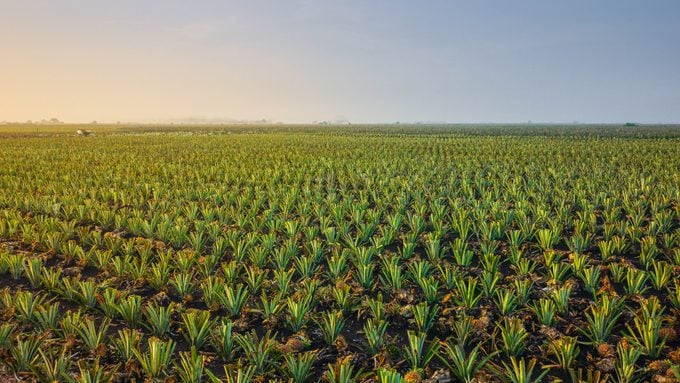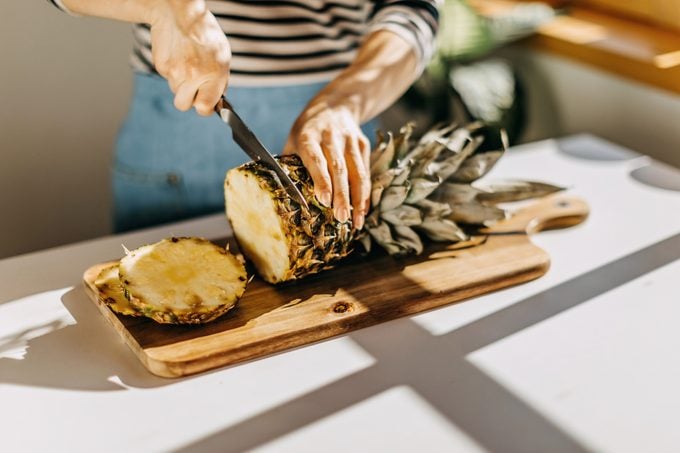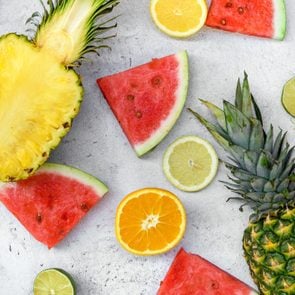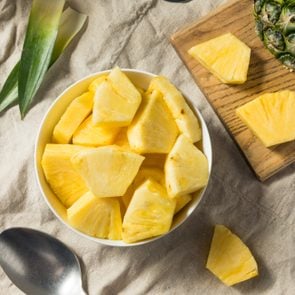10 Things Nutritionists Need You to Know About Pineapple
Updated: Mar. 16, 2022
Here's everything you need to know about pineapples, from nutrition and health benefits to tips for slicing up and eating the fruit.
Pineapples equal fun
Pineapples are a sweet, tangy, and delicious tropical fruit that is synonymous with summer and warm-weather fun. From piña coladas and pineapple upside-down cake to fruit salad, there are endless ways to enjoy pineapples.
If you’re a fan (and, really, who isn’t?), you might be wondering what exactly a pineapple is, where it’s grown, and whether it’s even good for you.
What is pineapple?
Pineapple is part of the Bromeliaceae family, explains Ellen Liskov, a registered dietitian with Yale New Haven Hospital.
Although it is not closely related to pine or apple trees, its name is a purposeful combination of the two. Early European colonizers, who first experienced its deliciousness after landing in South America, thought it looked like a pine cone but tasted like an apple.
Plenty of people wonder if pineapples are a citrus fruit—the answer is nope. If you want to get technical, you can call it a “multiple” fruit, so categorized because it forms from multiple flowers that fuse together.
But most people consider it a tropical fruit, thanks to its native climate.
How does it grow?
Unlike pine cones and apples, pineapples do not grow on trees. Instead, they grow from small shrubs that need a year or two of growth before they can bear fruit.
“The pineapple grows from a plant close to the ground, [and] unlike many tree-borne fruits, the pineapple actually grows from itself,” says Lacey Dunn, a registered dietitian based in Houston. “To grow a pineapple, you can plant a pineapple head directly in the ground.”
The pineapple plant produces leafy stems, with the fruit growing from their leafy tops. These tops produce small purple flower clusters that eventually fall off, revealing purple tubes that swell to produce a green pineapple.
“Once fully grown, within five to six months of time, the pineapple turns a yellow/orange, signaling that it’s ready for harvest,” Dunn says.

Where is it grown?
The pineapple is native to tropical South America, where the plant was first domesticated and cultivated. The first large-scale plantations were established in Hawaii, however, which dominated pineapple production well into the 20th century.
Major pineapple-producing countries today include Costa Rica, the Philippines, Brazil, Thailand, and Mexico.
Are there different types?
There are many different types of pineapple, which vary in taste, color, and origin, Dunn says.
There are four main classes, according to a summary by the late American botanist Julia F. Morton, who deemed there “is much variation in the types within each class.”
Smooth cayenne pineapple
The smooth cayenne variety is the most common type of pineapple, Dunn says, accounting for about 90 percent of all canned pineapple.
It has an orange rind and yellow flesh and is larger, juicier, and sweeter than some of the other varieties, especially the Red Spanish.
Red Spanish pineapple
The red Spanish variety is “more green in color,” Dunn says.
According to Morton, despite being “spiny,” it’s still the most popular among growers in the West Indies, Venezuela, and Mexico, constituting 85 percent of all commercial planting in Puerto Rico and 75 percent of the production for the fresh fruit market.
Queen
This is mostly cultivated in South Africa, Australia, and the Philippines. The plant is smaller, compact, more cold-resistant, more disease resistant, less fibrous, and more fragrant than smooth cayenne.
It matures its fruit early but suckers freely and needs thinning, and the yield is low. It is often sold fresh and is rarely canned due to its shape.
Abacaxi
This pineapple is commonly grown in Brazil, the Bahamas, and Florida. It has a small core and is very fragrant, with white or very pale yellow flesh that is very rich, sweet, and juicy.
“This is rated by many as the most delicious pineapple,” Morton explains. Because it is very tender, however, it is difficult to sell commercially.
What’s the nutritional profile?
Dunn notes that pineapple is 86 percent water, which makes it a great, hydrating food.
Here are the nutrients in one cup (165 grams) of raw pineapple chunks:
Calories: 74
Protein: 1 g (2 percent of the daily recommended value, or DV)
Fat: 0 g (0 percent DV)
Sodium: 2 mg (0.08 percent DV)
Carbohydrates: 19.5 g (7 percent DV)
Fiber: 2 g (7 percent DV)
Vitamin D: 0 ug (0 percent DV)
Vitamin C: 28 mg (31 percent DV)
Iron: 0.41 mg (2 percent DV)
Potassium: 206 mg (4 percent DV)
Dunn also notes that a 100-gram serving of fresh pineapple offers 46 percent of the recommended daily value of manganese.
What are the benefits?
Pineapple is loaded with antioxidants, vitamins, and minerals, making it a fantastic fruit to incorporate into a healthy diet, Dunn says.
It can help boost immunity
Being a rich source of vitamin C, pineapple can strengthen the immune system, “helping to ward off viral and bacterial infections as well as fight off inflammation,” Dunn says.
It can help boost collagen production
According to a 2017 study published in the medical journal Nutrients, vitamin C is an antioxidant that helps support collagen production.
This could make pineapple “helpful in skin vitality and brightness and in fighting acne,” Dunn says. It’s one reason why pineapple is a popular ingredient in many skin-care products.
It might ward off cancer
Pineapple might have the potential to fight cancer and other diseases, Dunn says.
“In addition to being anti-inflammatory, it also has anti-cancer and antimicrobial properties, allowing it to help reduce the risk of developing chronic disease and reduce the risk of acquiring foodborne illnesses,” she explains, citing a 2016 study published in Biomedical Reports.
It can help strengthen your bones
Pineapple helps support strong bones, thanks in part to its manganese content, according to a 2016 study published in Clinical Cases in Mineral and Bone Metabolism.
“Manganese helps to support bone mineral density and strength, giving pineapple a punch for helping to fight and prevent osteoporosis,” says Dunn.
It is a great digestion aid
Pineapple can also help with digestion, as it contains fiber, water, and a protease digestive enzyme called bromelain, which can reduce gas and bloating and normalize bowel functions, Dunn says.
“This makes it an excellent snack and meal additive for those struggling with constipation, diarrhea, and IBS [irritable bowel syndrome],” she says.
It can help reduce inflammation
Bromelain helps reduce inflammation and can be helpful for combating muscle and joint pains, especially in those with osteoarthritis, explains Dunn, citing a few studies, including a 2012 paper published in Biotechnology Research International.
It can help control blood pressure
Dunn explains that pineapple can be used to help control high blood pressure.
It’s rich in potassium, which is important for regulating blood pressure, as evidenced by a highly cited study published in the Journal of the American Society of Nephrology.
Is there such a thing as too much pineapple?
“Fresh pineapple overall has few downsides or risks with consumption when enjoyed in moderation with a healthy balanced diet,” Dunn says. Still, there are a few potential things to look out for.
It might induce gas and bloating
Despite its potential to reduce gas and bloating, Dunn explains that eating too much pineapple could have the opposite effect, “due to its higher fructose and water content.”
It could give you heartburn
Those with gastroesophageal reflux disease (GERD) may also notice an increase in symptoms of heartburn after eating pineapple, due to its higher acidity, Dunn notes.
It can raise blood sugar
Because pineapple is relatively high in sugar, some people—like those with diabetes—need to be extra careful with how much they consume.
You can certainly eat pineapple if you have diabetes. But you’ll want to consider the carbs. “Those with diabetes should include [it] in their carbohydrate monitoring,” Liskov says.
Dunn also suggests paying attention to the ingredients in pineapple from a can. If they’re packed in syrup, that adds to the overall carb amount.
“Canned pineapple can be packed in syrups high in inflammatory added sugars,” she explains. “If purchasing canned, choose one canned in its own juices or water only.”
(Here’s more useful info on consuming fruit and managing diabetes.)

How do people prepare and eat pineapple?
There are a variety of ways to eat pineapple.
“Pineapple can be enjoyed fresh and raw by itself, on salads, within salsa, or thrown in smoothies. It can also be used for creating juices, sauces, or dressings, adding a natural sugar sweetness,” Dunn says.
Pineapple can be cooked warm, cooked from the grill with kebabs, in a stir fry, or as a part of a sandwich, wrap, or burger.
How to cut it
The easiest way to cut a pineapple is to cut off the top of the leafy crown by laying the pineapple on its side.
“Once the crown is off, sit the pineapple straight up, and using a sharp knife, slice the tough, spikey rind away from top to bottom, removing browned spots as you go,” Dunn says.
Once the skin is removed, you can cut the pineapple in half and quarters, slicing it into thick wedges or bite-sized chunks.
“Make sure to cut around and discard the core, however, which is too fibrous to chew and enjoy,” Dunn notes.
“If you want pineapple rings, after you have cut off the sides, lay the pineapple down horizontally and use your knife to slice into one- to two-inch rounds,” Dunn says. “Then, using a small cookie cutter, you can remove the inner core.”
Can you freeze it?
You can and should freeze pineapple, says Liskov, who recommends freezing small pieces on a baking sheet lined with wax paper.
“Once frozen, put them in a zip-lock baggie and store them in the freezer,” she suggests. If you find the quality suffers when thawing it, use it in pineapple smoothies instead.
How can you tell if a pineapple is ripe?
There’s an easy way to tell if a pineapple is ripe.
“Ripe pineapple will have a small ‘give’ when gently squeezed and will be a yellow/orange color with crisp, green leaves,” says Dunn. “The pineapple, however, should not be too soft or have darkened brown spots, which indicate that the pineapple is too ripe.”
It should also have a distinctive pineapple smell—sweet and floral.
Pineapple recipes
Hearty Salmon Skewers Over Brown Rice
Liskov suggests trying this heart-healthy meal of pineapple, cherry tomato, and salmon skewers, which can be cooked in a skillet in just 15 minutes.
Pineapple Orange Frozen Yogurt
All you need is orange juice, nonfat vanilla yogurt, pineapple, and a blender to make this healthy sweet treat, recommended by Liskov.
Thai Pineapple Fried Rice
Pineapple is a popular ingredient in Thai fried rice, sometimes served in a pineapple shell at restaurants.
Dunn recommends trying this Thai fried rice recipe, which includes brown rice, coconut oil, soy sauce, chili garlic sauce, and fresh pineapple.
Crockpot Pineapple Chicken
Toss some chicken, pineapple, red bell peppers, water chestnuts, soy sauce, and a few other ingredients into a slow cooker. You will be treated to a sweet-meets-savory meal in just a few hours with this recipe recommended by Dunn.
Pineapple Banana Protein Smoothie
Dunn says pineapple is a great addition to any smoothie, like this blend of banana, pineapple, and almond milk, which can also be made with chia seeds and protein powder.
Air Fryer Pineapple
Yes, pineapple can even be cooked in an air fryer. Dunn recommends this easy recipe, which involves just honey and fresh pineapple.
Fresh Pineapple Salsa
Pineapple is an easy way to sweeten up your salsa, Dunn says. This salsa recipe features fresh pineapple, red bell pepper, red onion, lime juice, cilantro, and jalapeño to jazz up your tacos.



